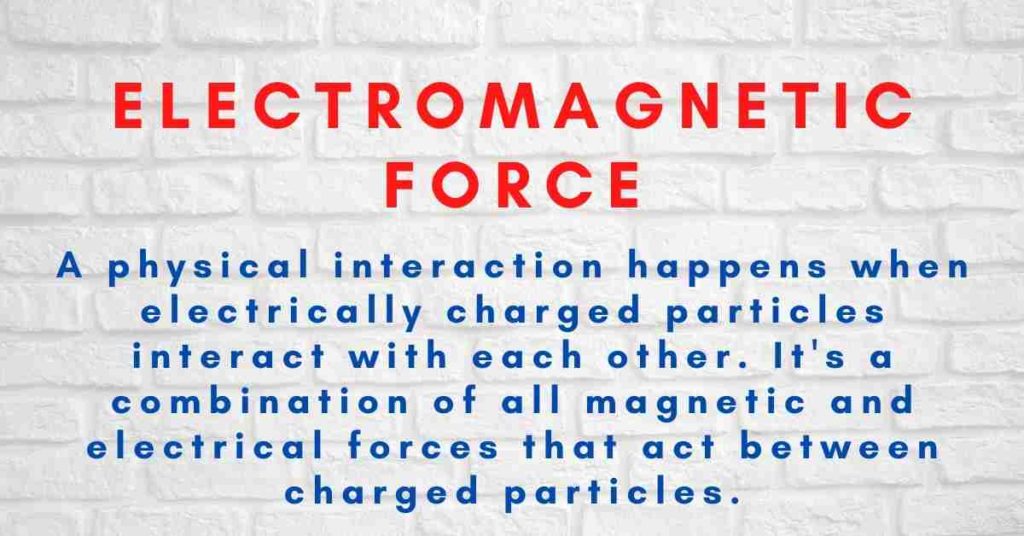The electromagnetic force is a sort of physical interaction that happens when electrically charged particles interact with each other. It is a combination of all magnetic and electrical forces that act between charged particles. Electromagnetic force can be both attractive and repulsive.

Table of Contents
Electromagnetic Force Definition
When a conductor is placed in a magnetic field and current flows in the conductor, the magnetic field and the current interact with each other to produce force. This force is called “Electromagnetic force”. Fleming’s left-hand rule determines the direction of the current, the magnetic force, and the flux.
The properties of electromagnetic force are as follows:
- It obeys the inverse square law.
- It may be attractive or repulsive in nature.
- It is a long-range force.
- The photon is the field particle of electromagnetic force.
An electromagnet is a magnet whose magnetic field is generated by an electric current. When the current is switched off, the magnetic field vanishes. The magnetic field is created by a large number of closely spaced turns of wire or coil in electromagnets.
Daily Life Examples of Electromagnetic Force
The electromagnetic force plays a crucial role in our daily lives and is involved in a multitude of activities and devices. Here are some examples of electromagnetic force in action:
- Electric motors: Electromagnetic force is the driving force behind electric motors, which are used in many appliances, including fans, power tools, and washing machines.
- Generators: Power plants generate electricity using electromagnetic induction, where a magnetic field induces an electric current in a wire.
- Light bulbs: Electromagnetic force is responsible for the operation of incandescent light bulbs, where an electric current passes through a wire filament, producing light and heat.
- Television and computer screens: Electromagnetic force is used to create images on television and computer screens by controlling the emission of electrons in a cathode ray tube.
- MRI (Magnetic Resonance Imaging): Electromagnetic force is used in medical imaging to create detailed images of the human body. A powerful magnetic field is used to align the magnetic moments of the nuclei of hydrogen atoms in the body.
- Mobile phones: Electromagnetic force is used in communication devices such as mobile phones, where electromagnetic waves are used to transmit information wirelessly.
- Compass: A compass uses the Earth’s magnetic field to determine direction. The needle of a compass is magnetized and aligns itself with the magnetic field, pointing towards the magnetic north pole.
These are just a few examples of the many applications of electromagnetic force in our daily lives.
Electromagnetic Force Formula
The Lorentz force refers to the total electromagnetic force F acting on a charged particle and is given by
| = | force | |
| = | electric charge | |
| = | external electric field | |
| = | velocity | |
| = | magnetic field |
Magnetism
The force exerted by magnets when they attract or repel one other is known as magnetism. The movement of electric charges causes magnetism.
Atoms are the basic building blocks of all things. Each atom contains electrons, which are charged particles. The nucleus of an atom is surrounded by electrons.
Their movement generates an electric current and causes each electron to act like a microscopic magnet.
The magnetism of most things is cancelled because equal quantities of electrons spin in opposing directions. As a result, materials like fabric and paper are classified as weakly magnetic. The majority of electrons in metals like iron, cobalt, and nickel spin in the same direction. The atoms in these compounds are extremely magnetic as a result of this, but they are not yet magnets.
To become magnetized, another strongly magnetic substance must enter the magnetic field of an existing magnet. The magnetic field is the area around a magnet that has a magnetic force.
The poles of all magnets are north and south. Poles that are opposite each other attract each other, whereas poles that are the same repel each other. When you rub a piece of iron against a magnet, the atoms’ north-seeking poles align in the same direction. A magnetic field is created by the force exerted by the aligned atoms. The iron has turned into a magnet.
An electric current can magnetize some materials. A magnetic field is created when electricity passes through a coil of wire. When the electric current is shut off, however, the field around the coil vanishes.
Current
The quantity of charged electrons passing across a circuit in a second is known as an electric current. The current, in simple terms, is the movement of electrons between two points that is induced by voltage. The difference in electric potential energy per unit of charge between two locations is known as voltage.
The terms AC and DC are used to describe different kinds of current flow in a circuit. The electric charge (current) in direct current (DC) only flows in one direction. In alternating current (AC), on the other hand, the direction of electric charge changes on a regular basis.
By convention, the direction of an electric current is the same as the movement of a positive charge. The current in the external circuit is therefore diverted away from the positive terminal of the battery and toward the negative terminal.
Electric field
The electric force per unit charge is defined as the electric field. The force that the field would impose on a positive test charge is assumed to be in the same direction as the field’s direction. A positive charge’s electric field is radially outward, whereas a negative charge’s field is radially inside.
Electromagnetism
Electromagnetism is one of the universe’s four basic forces. It explains how charged particles react to electric and magnetic forces, as well as the basic relationships that link them. All forces, including electromagnetism, are measured in Newtons.
Paramegnetic Materials
Metals that are weakly attracted to magnets are known as paramagnetic materials. Among them are aluminum, gold, and copper. The atoms of these compounds include electrons, the majority of which spin in the same direction, but not all. This gives the polarity of the atoms. These metals may produce very weak magnets because some of the atoms can be rotated to point their poles in the same direction.
Summary
The electromagnetic force is a type of force that exists between electrically charged particles. It is one of the four fundamental forces, and it manifests itself in electromagnetic fields such as magnetic fields, electric fields, and light.
Frequently Asked Questions
1. What causes an electromagnetic force?
The electromagnetic force, commonly known as the Lorentz force, describes how charged particles interact while they are moving or stationary. It’s termed the electromagnetic force because it combines the previously separate electric and magnetic forces; magnetic and electric forces constitute the same basic force.
2. Electromagnetic force definition?
The electromagnetic force is one of the four fundamental forces and exhibits electromagnetic fields such as magnetic fields, electric fields, and light.
It is the fundamental reason that electrons are attached to the nucleus and are accountable for the nucleus’ whole structure.
3. What is a Permanent magnet?
Permanent magnets are materials in which the magnetic field is created by the material’s intrinsic structure.
4. is magnetism a physical property?
Because attracting anything to a magnet does not affect the substance’s composition and does not require chemical processes, magnetism is a physical property.
5. How does an electromagnet work?
Electromagnets are constructed up of coils of wire that conduct electricity. Moving charges produce magnetic fields, thus when an electric current passes through the coils of wire in an electromagnet, the coils behave like a magnet.
6. Define magnetic pole?
The magnetic poles are the parts of the magnetic field where the magnet’s power is greatest. If a magnet is positioned in a free-turning position, it will rotate in a north-south direction. The north-seeking pole, or north pole, of the magnet, is the end that faces north.
7. Explain the interaction between electricity and magnetism?
Electromagnetism is the study of the interaction between magnetism and electricity. A magnet’s movement may create energy. A magnetic field may be created by the passage of electricity.
8. What are the types of magnets?
There are three main types of magnets: temporary, permanent, and electromagnets.
9. What is magnetic induction?
Magnetic induction is the process through which an ordinary piece of iron briefly acquires magnetic properties as a result of the presence of another magnet nearby. For example, a nail may be transformed into a magnet and acquire magnetic qualities.
10. What is magnetic permeability?
The resistance of a material to a magnetic field, or the amount to which a magnetic field may permeate through a substance, is measured by magnetic permeability.
11. What is surface charge density?
Surface charge density (σ) is the amount of charge per unit area, measured in coulombs per square meter (C⋅m−2), at any point on a two-dimensional surface charge distribution.
12. What is ampere’s law?
According to Ampere’s law, the integral of magnetic field density (B) along an imaginary line is equal to the product of free space permeability and current enclosed by the path.
Important Links
Magnetic field | Definition & Facts | Britannica
Electric Current Definition and Explanation
Surface Charge density
Electric Field of Sphere of Uniform Charge
London Dispersion Force| Definition and Examples
Electric Susceptibility| Definition and Simple Explanation
Power Units- The Basics
- BCl3 Lewis Structure in four simple steps - November 1, 2023
- PH3 Lewis Structure in four simple steps - October 8, 2023
- PF3 Lewis structure in four simple steps - September 24, 2023



